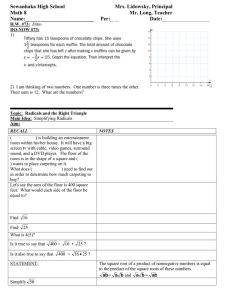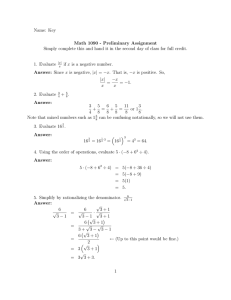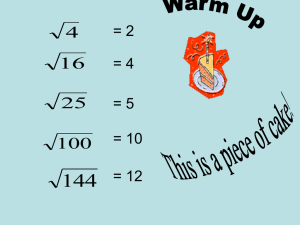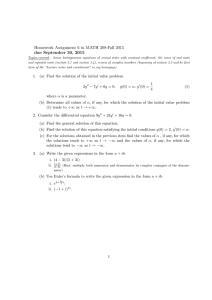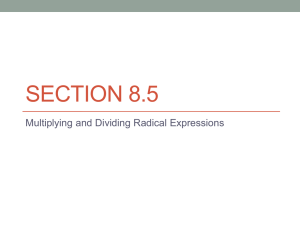8.2 Simplifying Square Roots
advertisement
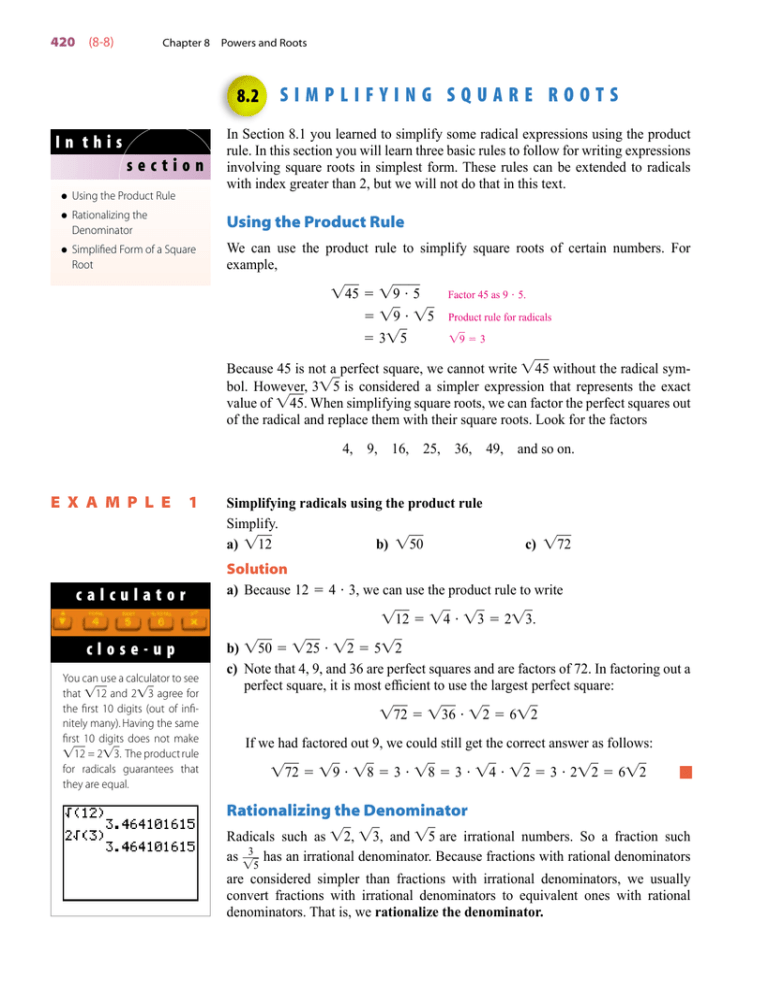
420 (8-8) Chapter 8 Powers and Roots 8.2 In this section SIMPLIFYING SQUARE ROOTS In Section 8.1 you learned to simplify some radical expressions using the product rule. In this section you will learn three basic rules to follow for writing expressions involving square roots in simplest form. These rules can be extended to radicals with index greater than 2, but we will not do that in this text. ● Using the Product Rule ● Rationalizing the Denominator Using the Product Rule ● Simplified Form of a Square Root We can use the product rule to simplify square roots of certain numbers. For example, 5 9 5 4 Factor 45 as 9 5. 9 5 Product rule for radicals 35 9 3 Because 45 is not a perfect square, we cannot write 4 5 without the radical sym is considered a simpler expression that represents the exact bol. However, 35 value of 45. When simplifying square roots, we can factor the perfect squares out of the radical and replace them with their square roots. Look for the factors 4, E X A M P L E 1 calculator 9, 16, 25, 36, Simplifying radicals using the product rule Simplify. 2 b) 5 0 a) 1 49, and so on. c) 7 2 Solution a) Because 12 4 3, we can use the product rule to write 12 4 3 23. close-up You can use a calculator to see that 12 and 23 agree for the first 10 digits (out of infinitely many). Having the same first 10 digits does not make 12 = 23. The product rule for radicals guarantees that they are equal. b) 5 0 2 5 2 52 c) Note that 4, 9, and 36 are perfect squares and are factors of 72. In factoring out a perfect square, it is most efficient to use the largest perfect square: 62 72 36 2 If we had factored out 9, we could still get the correct answer as follows: 72 9 8 3 8 3 4 2 3 22 62 ■ Rationalizing the Denominator Radicals such as 2 , 3, and 5 are irrational numbers. So a fraction such 3 as has an irrational denominator. Because fractions with rational denominators 5 are considered simpler than fractions with irrational denominators, we usually convert fractions with irrational denominators to equivalent ones with rational denominators. That is, we rationalize the denominator. 8.2 E X A M P L E 2 Simplifying Square Roots (8-9) 421 Rationalizing denominators Simplify each expression by rationalizing its denominator. 3 3 a) b) 7 5 Solution a) Because 5 5 5, we multiply numerator and denominator by 5: 3 5 3 5 5 5 35 5 Multiply numerator and denominator by 5. 5 5 5 b) Because 7 7 7, multiply the numerator and denominator by 7: 3 3 7 7 7 7 21 7 Multiply numerator and denominator by 7. Product rule for radicals ■ Simplified Form of a Square Root When we simplify any expression, we try to write a “simpler” expression that is equivalent to the original. However, one person’s idea of simpler is sometimes different from another person’s. For a square root the expression must satisfy three conditions to be in simplified form. These three conditions provide specific rules to follow for simplifying square roots. Simplified Form for Square Roots An expression involving a square root is in simplified form if it has 1. no perfect-square factors inside the radical, 2. no fractions inside the radical, and 3. no radicals in the denominator. Because a decimal is a form of a fraction, a simplified square root should not contain any decimal numbers. Also, a simplified expression should use the fewest rather than 2 3 even though number of radicals possible. So we write 6 and 3 are both in simplified form. both 2 E X A M P L E 3 Simplified form for square roots Write each radical expression in simplified form. 2 a) 3 00 b) 5 10 c) 6 Solution a) We must remove the perfect square factor of 100 from inside the radical: 003 1 00 3 103 300 1 422 (8-10) Chapter 8 Powers and Roots b) We first use the quotient rule to remove the fraction calculator 5 2 5 2 close-up from inside the radical: Quotient rule for radicals 2 5 5 5 10 5 Using a calculator to check simplification problems will help you to understand the concepts. 2 5 Rationalize the denominator. Product rule for radicals c) The numerator and denominator have a common factor of 2 : 10 2 5 6 2 3 5 3 5 3 3 3 15 3 Product rule for radicals Reduce. Rationalize the denominator. Product rule for radicals 10 Note that we could have simplified by first using the quotient rule to get 10 6 10 6 and then reducing 10 . 6 6 Another way to simplify 10 6 is to first . You should try these alternamultiply the numerator and denominator by 6 15 tives. Of course, the simplified form is by any method. 3 ■ In the next example we simplify some expressions involving variables. Remember that any exponential expression with an even exponent is a perfect square. E X A M P L E 4 Radicals containing variables Simplify each expression. All variables represent nonnegative real numbers. a) x3 b) 8 a9 c) 1 8a4b7 Solution a) x3 x2x x2 x xx The largest perfect square factor of x 3 is x 2. Product rule for radicals For any nonnegative x, x2 x. b) 8 a9 4 a8 2 a 2a 42a The largest perfect square factor of 8a 9 is 4a 8. 4a8 2a 4 c) 1 8a4b7 9 a4b6 2b 3a b 2b 2 3 Factor out the perfect squares. 9a4 b6 3a 2b3 ■ 8.2 Simplifying Square Roots (8-11) 423 If square roots of variables appear in the denominator, then we rationalize the denominator. E X A M P L E 5 Radicals containing variables Simplify each expression. All variables represent positive real numbers. 5 a) a a b) b 2 c) 6a helpful hint If you are going to compute the value of a radical expression with a calculator, it doesn’t matter if the denominator is rational. However, rationalizing the denominator provides another opportunity to practice building up the denominator of a fraction and multiplying radicals. Solution 5 5 a a) a a a 5a a b) b a b a Multiply numerator and denominator by a . a a a Quotient rule for radicals a b b b Rationalize the denominator. ab b Product rule for radicals 2 6a 2 c) 6 a 6 a 6a 12a 6a 4 3 a 6a 23a 6a 23a 2 3a 3a 3a CAUTION Rationalize the denominator. Product rule for radicals Factor out the perfect square. 4 2 Factor the denominator. Divide out the common factor 2. ■ Do not attempt to reduce an expression like the one in Example 5(c): 3a 3a You cannot divide out common factors when one is inside a radical. 424 (8-12) Chapter 8 WARM-UPS Powers and Roots True or false? Explain your answer. 1. 2 0 25 True 2. 18 92 False 3 9 3 1 3. True 4. False 3 4 2 3 3 5. a aa for any positive value of a. True 3 9 6. a a for any positive value of a. False 7. y17 y 8y for any positive value of y. True 6 8. 3 False 9. 4 2 False 10. 2 83 17 2 8. 2 False EXERCISES Reading and Writing After reading this section, write out the answers to these questions. Use complete sentences. 1. How do we simplify a radical with the product rule? We use the product rule to factor out a perfect square from inside a square root. 2. Which integers are perfect squares? The perfect squares are 1, 4, 9, 16, 25, and so on. 3. What does it mean to rationalize a denominator? To rationalize a denominator means to rewrite the expression so that the denominator is a rational number. 4. What is simplified form for a square root? A square root in simplified form has no perfect squares or fractions inside the radical and no radicals in the denominator. 5. How do you simplify a square root that contains a variable? To simplify a square root containing variables, use the same techniques as we use on square roots of numbers. 6. How can you tell if an exponential expression is a perfect square? Any even power of a variable is a perfect square. Assume that all variables in the exercises represent positive real numbers. Simplify each radical. See Example 1. 7. 8 22 8. 20 25 9. 24 26 10. 7 5 53 11. 2 8 27 12. 40 210 13. 9 0 310 14. 200 102 15. 500 105 16. 9 8 72 17. 150 56 18. 120 230 Simplify each expression by rationalizing the denominator. See Example 2. 1 1 3 19. 20. 21. 5 6 2 5 6 32 5 6 2 4 3 7 23. 24. 22. 3 2 6 43 42 6 3 6 2 10 3 4 26. 27. 25. 17 10 5 45 310 1017 5 10 17 11 10 3 29. 30. 28. 7 3 19 77 30 319 7 3 19 Write each radical expression in simplified form. See Example 3. 3 32. 48 33. 31. 63 2 6 37 43 2 3 5 5 34. 35. 36. 5 8 18 15 10 10 5 4 6 6 12 75 37. 38. 39. 10 20 3 15 15 5 5 5 45 40. 5 3 15 41. 10 6 2 30 42. 21 70 7 8.2 Simplify each expression. See Example 4. 43. a 8 44. y10 45. a9 a4 y5 a4a 46. t11 t 5t 47. 8a6 2a32 48. 18w 9 4 3w 2 w 4b9 49. 2 0a 2a2b45b 50. 12y x23 2xy3 y 51. 27y x33 3xy3 xy 52. 4 5y x53 2 3x y5xy 53. 27a3b8c2 3ab4c3a 9 4 54. 125y x3z 4 2 5xy z 5xy Simplify each expression. See Example 5. 1 1 55. 56. 57. x 2x x 2x x 2x 3 5 59. 60. 58. 15y 2b 10b 5y 2b 5y 3x 6 61. 62. 63. 2y 5w 6 30w xy 2y 5w 64. 6x 4y xy 6 2y 8yx 3 65. 2x2xy y Simplify each expression. 67. 8 0 x3 68. 90 y80 40 4x5x 3y 10 20x6 70. 4 8y x27 71. x5 5 4xy33y 4x 35x 22p2 30t 5 73. 74. p6pq t 23t 116pq 3q 3n4b5n2b2c7 76. nbc 3n4b5c3nb 10t23t 4xy2 77. x9y36 xy3 6y 94 3x y 2 3a 6a 3a 5 10x 2x 2x 10y 15x 6 xy 3x Simplifying Square Roots (8-13) 425 Solve each problem. 83. Economic order quantity. The formula for economic order quantity E I 2AS was used in Exercise 83 of Section 8.1. a) Express the right-hand side in simplified form. 2 AIS E I b) Find E when A 23, S $4566, and I $80. 51.2 8ts 5 66. 2s22st t 69. 9x y915 4 7 3y x yx 7x7y 72. 7 x9 x 2y7x a3b7a2b3c4 75. abc a3b8cac 8m 3n2 78. m3n26m n 3 23n 3m2n3 Use a calculator to evaluate each expression. 2 2 6 1 79. 80. 2 3 3 2 0 0 20 6 81. 3 82. 2 5 2 0 0 FIGURE FOR EXERCISE 83 84. Landing speed. Aircraft design engineers determine the proper landing speed V (in ft/sec) by using the formula V 841L , CS where L is the gross weight of the aircraft in pounds, C is the coefficient of lift, and S is the wing surface area in square feet. a) Express the right-hand side in simplified form. 29L C S V CS b) Find V when L 8600 pounds, C 2.81, and S 200 square feet. 113.4 FIGURE FOR EXERCISE 84
